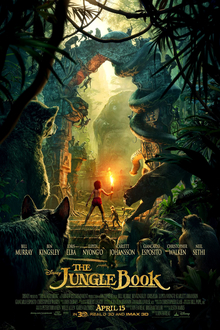 This was an interesting film, not just because of the amazing advances in technology since the 60s which allowed this to be live-action* but also because of the shift in message of the new version. More on that in a minute.
This was an interesting film, not just because of the amazing advances in technology since the 60s which allowed this to be live-action* but also because of the shift in message of the new version. More on that in a minute.Mowgli (Neel Sethi) has been raised by wolves in the jungle after having been found as an infant by Bagheera (Ben Kingsley) the panther. He doesn't fit in, however, since his development rate is so different than his furry brothers and he cannot keep up with their games without resorting to "man tricks" like using tools and non-linear thinking. He is generally accepted and loved despite these differences. The notable exception is Shere Khan (Idris Elba) the tiger, who hates Mowgli for what he represents: mankind and their associated incursions and unintended consequences. Bagheera decides that for Mowgli's safety, he must be returned to the man village. Along the way, they are separated and Mowgli comes under the care of Baloo (Bill Murray) the bear. Initially, Baloo is only interested in using Mowgli for his own ends but soon comes to care for the boy. Baloo agrees to help Bagheera take Mowgli back to the village, but when Mowgli learns that Akela (Giancarlo Esposito) the wolf has been killed by Shere Khan, he is determined to go back and face the tiger.
Okay, here is where the rubber meets the road. In the original Disney movie, Mowgli is caught unawares and defenseless by Shere Khan but a fortuitous lightning strike creates fire in the dry grass of the plain. Mowgli ties a burning stick to Shere Khan's tail and scares the big cat away. Then he goes to the human village, sees a girl, and happily follows her into the village to be with his own kind.
In the NEW movie, Mowgli sneaks into the village to steal a burning torch, intent on using it against Shere Khan. While running back to the wolf pack, embers drop behind him, setting fire to the surrounding jungle. Khan points this out as Mowgli's inherent human failure to refrain from destroying everything he touches. In disgust, Mowgli puts out the torch and calls on the wolf pack to aid him, basically slowing down the tiger so he can think of something smarter. He races into the inferno and uses "man tricks" to lure the tiger onto a dead branch, which breaks and sends the tiger to a fiery death while Mowgli swings free. He then rejoins the wolf pack, his adopted family.
This represents a totally different ideology. It is no longer "fish out of water has adventures but finally goes back where he belongs" but "fish develops personal sense of identity through trials and along the way opens others' minds as to the subversion of traditional labels." Now whether that is good or bad depends on you, the viewer, but I couldn't get over what an interesting change it was and what it says about us as a society (our values and cultural conditioning) now as opposed to fifty years ago.
*ish. It is 90% CGI so the term "live" is a little misleading, but the little boy was human and some of the cinematography was real (maybe).
Because this did so well, we're now getting (from the same team, including director John Favreau) a "live action" The Lion King. Which will of course follow the heels of Beauty and the Beast. I actually never liked the Jungle Book in any of it's forms. Not the original Kipling, not the animated, and not the CG. I also didn't care for the mid-90's version starring Jason Scott Lee. I did like the alternate-universe version of it, though, the cartoon series TaleSpin. To be fair, I've never liked any of Kipling's works.
ReplyDelete